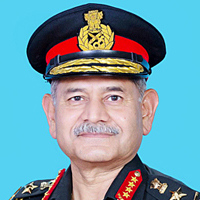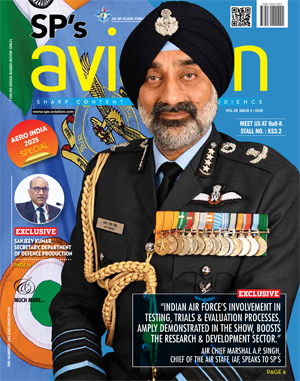INDIAN ARMED FORCES CHIEFS ON OUR RELENTLESS AND FOCUSED PUBLISHING EFFORTS

The insightful articles, inspiring narrations and analytical perspectives presented by the Editorial Team, establish an alluring connect with the reader. My compliments and best wishes to SP Guide Publications.

"Over the past 60 years, the growth of SP Guide Publications has mirrored the rising stature of Indian Navy. Its well-researched and informative magazines on Defence and Aerospace sector have served to shape an educated opinion of our military personnel, policy makers and the public alike. I wish SP's Publication team continued success, fair winds and following seas in all future endeavour!"

Since, its inception in 1964, SP Guide Publications has consistently demonstrated commitment to high-quality journalism in the aerospace and defence sectors, earning a well-deserved reputation as Asia's largest media house in this domain. I wish SP Guide Publications continued success in its pursuit of excellence.
Search for a Medium Lift Helicopter
The Indian Multi-Role Helicopter (IMRH), offering diverse capabilities, is being developed to cater to both military and civilian applications

The search for replacements for the ageing fleet of helicopters in the armed forces began over three decades back. The light helicopter fleet of French origin Chetak and Cheetahs were inducted way back in 1970s. The soviet origin Mi series of medium lift helicopters (Mi-17/Mi-17IV/Mi-17V5 and Mi-8s) also needed replacements in phases. Some RFPs reached trials stage by 2003-4 including flight tests in the high altitude terrain of Leh and Siachen where the helicopters are the workhorse for induction and sustenance in these remote locations. However, as is the case with many high value procurement proposals, these didn’t fructify beyond the price negotiation stage for a variety of reasons. The AgustaWestland VVIP chopper deal which involved a multimillion-dollar corruption case amounting to ₹2.5 billion ($29 million), transferred through bank accounts in the UK and UAE and paid to middlemen and Indian officials in 2006 and 2007 got exposed in 2013 leading to much hesitation to progress further procurements for urgent tri-service needs.
INDUCTION OF ALH AND SAFETY CONCERNS
In a parallel development, the much delayed Advanced Light Helicopter (ALH) Dhruv designed and developed by Hindustan Aeronautics Limited (HAL), a project initiated way back in November 1984, finally began to enter service in 2002. As of January 2025, more than 400 Dhruvs had been produced for domestic and export markets logging more than 3,50,000 flying hours. It was supposed to be a symbol of India’s growing self-reliance in defence—a sleek, home-grown military helicopter capable of handling diverse missions across land, sea and mountains. Instead, the Dhruv, has found itself mired in a troubling pattern of crashes, raising serious questions about its safety, design and reliability. The helicopters have been involved in 15 crashes over the past five years. The latest on January 5, 2025 when an ALH of the Indian Coast Guard (ICG) crashed near Porbandar, Gujarat killing all three crew. After the latest crash, the entire fleet of around 330 ALHs in service have been grounded for safety checks.
The crisis with Dhruv helicopters is a dampener for government’s ambitious ‘Make in India’ project of Atmanirbharta in the defence sector. When the Indian military inducted these choppers, the moment was seen as a milestone for indigenous defence aviation. The ALH has since been exported to multiple nations and has undergone several upgrades, leading to advanced variants such as ALH Mk III and ALH Mk IV (Rudra). The ALH Mk III features a Shakti engine developed in collaboration with France’s Safran, a glass cockpit, night vision capability, advanced marine patrol radar and an electronic warfare suite. The ALH Mk IV is an armed variant equipped for attack, close air support and high-altitude operations.
The grounding of all Dhruv helicopters is a dampener for government’s ambitious ‘Make in India’ project of Atmanirbharta in the defence sector
Safety probes have identified issues with hydraulics and control rod failures impacting rotor blade power input, prompting the replacement of defective rods across the fleet. The control rod in ALH is made of aluminium and HAL decided to replace it with steel control rods in some helicopters. In the latest crash of January 5, 2025, the Council of Scientific and Industrial Research – National Aerospace Laboratories (CSIR–NAL), Bengaluru has found that swashplate assembly in the transmission system compromised the pilots’ ability to control the helicopter’s motion. These safety issues have cast a shadow over its operational credibility. It is hoped that greater technological partnership, especially with the burgeoning private sector defence industry and collaboration with French and the US aviation giants, which have progressed well in the past few years, will see these issues resolved.
GOING THE “INDIGENOUS” ROUTE
In other segments of the helicopter fleet in the services, the induction of the Boeing AH-64E Apache attack helicopters and CH-47F (I) Chinook heavy lift helicopters by the IAF in 2019 was a momentous milestone and augmented urgently needed capabilities. The IAF’s helicopter fleet has steadily been increasing over the years, going up from a handful of US types in the sixties to over 500 French, Indian and Soviet built types. The Russian Mi-26, however, remains the potent force in the IAF’s heavy lift helicopter capability.
In the medium lift utility helicopter category, the HAL has made substantial progress even as it struggles with the above mentioned safety issues with the light utility helicopter Dhruv. The Indian Multi-Role Helicopter (IMRH) is being developed to cater to both military and civilian applications. It is expected to offer capabilities such as troop transport, search and rescue, airattack, anti-surface, anti-submarine warfare, electronic warfare, and VIP transport roles. IMRH will be the first major project to follow new manufacturing policy under Defence Acquisition Procedure (DAP) 2020. As per the policy, a private sector entity will form Special Purpose Vehicle (SPV) with HAL by acquiring 51 per cent stake after getting minimum order assurance from Indian Armed Forces. During delivery, the company will be free to export 25 per cent of the production to a third country. An estimated ₹11,000 crores will be required as development cost for seven years and another ₹12,000 crores for setting up manufacturing facilities. The total requirement of the Indian Armed Forces is 550 units. The IAF currently operates a fleet of over 220 medium lift helicopters, Mi-17 and its variants Mi-17IV and Mi-17V5, primarily used for utility and troop transport.
The IMRH helicopter will have a five bladed main rotor with a diameter of 21.2 meters and a four-blade tail rotor. MRH will have 75 per cent domestic content but will use an imported 2000 kW turboshaft engine. French aviation giant Safran Helicopter Engines and Hindustan Aeronautics Limited (HAL) signed a workshare agreement on February 15, 2023 at Bengaluru for the joint development of the engine intended for the future 13-tonne IMRH and its naval version DBMRH (Deck Based Multi-Role Helicopter). Payload capacity at sea level will be four tonnes and 1.5 tonne at a height of 13,000 ft (4,000 m). The cabin dimension allows up to 36 passengers in three rows and meets the specified mission requirements and should be able carry an internal cargo of 4,000 kg. An external hook is to be provided to transport cargo up to 4,000 kg as an optional fit.
HAL has set up a new Helicopter Factory at Tumkur that will produce helicopters of three tonne to 12 tonne category. Inaugurated in February 2023, the HAL plant has plans to produce more than 1,000 helicopters in the range of 3-15 tonnes, with a total business of over Rs four lakh crores over a period of 20 years. The factory will enable India to meet its entire requirement of helicopters without import.
ROLE OF THE PRIVATE SECTOR
Instead of relying solely on the PSU manufacturer HAL, the government has given the go-ahead to multiple private sector initiatives in the aviation sector to boost indigenous capacities. Tata Boeing Aerospace Limited, a joint venture between Tata and Boeing produces aero-structures for Apache helicopters and Boeing 737 airplanes in Hyderabad. The Tata-Airbus plant in Vadodara will manufacture C295 defence transport aircraft, the first private sector final assembly line for military aircraft in India. From making the C295 military transport aircraft in India to making a civil commercial aircraft indigenously will be a very long and complex pathway, but India has announced its grand ambition for a Made-in-India civil aircraft.
French defence major Dassault Aviation has filed an application with the Indian government to set up a maintenance, repair and overhaul (MRO) facility near Jewar international airport in Uttar Pradesh to cater to not just India’s fleet of Mirage 2000s and Rafale fighter jets, but also that of Indonesia. Mahindra Aerospace has led the Mahindra Group’s foray into utility aircraft and aerostructure manufacturing since 2008. Its utility aircraft business, based in Australia, currently produces the Airvan 8, the most capable, rugged and versatile utility aircraft in its class. Certified in 38 countries, over 200 are in service. Mahindra Aerospace is also developing a 10-seat turboprop, the Airvan 10 The Aerostructures business operates out of a new 25,000 sq. m. facility located at the Narsapura Industrial Estate, about 40 km east of Bengaluru city.
These are very exciting developments Indian aviation sector. This developing ecosystem will help immensely in development and production of military and civil use aircrafts, helicopters and drones of the future, giving much needed fillip to the Prime Minister’s vision of ‘Atmanirbhar Bharat’.
The author retired from the Indian Army after 37 years of experience as a helicopter pilot.





